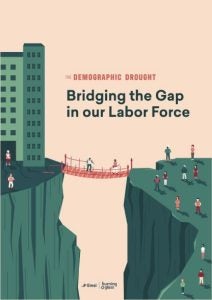- 4 million immigration visas stuck in processing
- 6 million unengaged U.S. workers
- 11 million job openings


Early in 2021, Emsi Burning Glass released The Demographic Drought , a sobering look at the current and future state of the US labor force. We explored how surging Baby Boomer retirements, declines in labor force participation amongst millennials, ebbing birth rates, and falling immigration numbers help explain why the US is facing talent shortages and near record-low unemployment.
In that report, we also projected that the US labor force would eventually start to decline—with far more job openings than people available to fill them—as permanent retirees outpace new labor force entrants. Even before the pandemic, the US was set up to face a talent deficit of six million people by the end of the decade.
Then, the COVID-19 pandemic struck and hit the accelerator on many of these long-term trends. Almost overnight, our future labor crisis became a present reality. We now face a record 11 million job openings. With 5 million unengaged workers on the sidelines and more than 4 million immigration visas stuck in processing , the same question is on everyone’s minds: How can we fill the labor force gap?
The Current Labor Force Gap
How do we bridge the gap in our labor force?
In a time of change and a desperate need for workers, people can only come from two sources. Will you rely on immigration to solve your problem or will you actively pursue unemployed and unengaged workers?